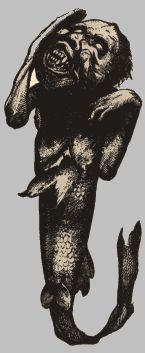You have your new house, and you’ve just settled in. The paint is dry on the ceiling of your porch. The house is clean, and being the fae believer that you are, you’ve been putting out some wheat and milk every night.
Poking around your garden one night you find something that absolutely amazes you. Can it be that you’ve been right all along, and you’ve just stumbled onto the graveyard of some of the demi-fae?! You begin to wonder about what you should do to keep some of their bigger bretheren out of your home…
Not so fast.
The act of hoaxing the general public is not nearly as new as the Internet. There are theories that the Cerne Abbas Giant may be a hoax dating to the 17th century. The Cardiff Giant certainly is-he led to the odd legal decision that a hoax of a hoax is allowable. Mark Twain even got in on the action, writing a piece called ‘The Petrified Man’ while he was a reporter.
While our winged friend up there may be lurking in a gray area of believability-I didn’t realize that faeries came in toy Army man green-one of the biggest ‘created’ hoaxes of in a similar vein was the Fiji Mermaid. The Fiji Mermaid, which was made famous by the sideshow craze of the late 19th century, was most often the top half of a monkey sewn onto the bottom half of a fish. The most famous mermaid was shown by P.T. Barnum.
The original mermaid was destroyed in a fire, but others were made. Such creatures are called gaffs-smaller acts used to create interest in side shows. What does this have to do with our Fair buddy? If he is in fact a fake (more on that in a moment) he’s hardly the first.
One of the most famous of the faerie-frauds were the Cottingley Fairies of 1917. The photographs showed what alleged to be fairies frolicking with two small girls. While the photographs now look almost innocent in their assertion that those creatures are fairies, as opposed to faerie cut-outs on sticks and pins, the photographs caused an uproar of interest. Famous Spiritualists supported the claims including Sir Arthur Conan Doyle. The hoax wasn’t disproven until the 1980s when one of the two cousins involved finally admitted the perhaps obvious, that the faeries were cardboard.
 …As an aside though, the cousins are on record that while those faeries were fake, they had seen some that weren’t.
…As an aside though, the cousins are on record that while those faeries were fake, they had seen some that weren’t.
Which brings us back to our jolly green friend. Our airborne companion up there has been making the rounds online since 2007 when he was released as an April Fool’s Day prank. Barnum may have been a promotional genius, but he didn’t have the Internet to help him. The faerie has been outed as a fraud by his own creator (a prop maker named Dan Baines), but that doesn’t stop people from believing that he’s geniune proof of the fae.
I suppose as long as people want to believe in the fantastical, there will be people to believe in the fantastical.

